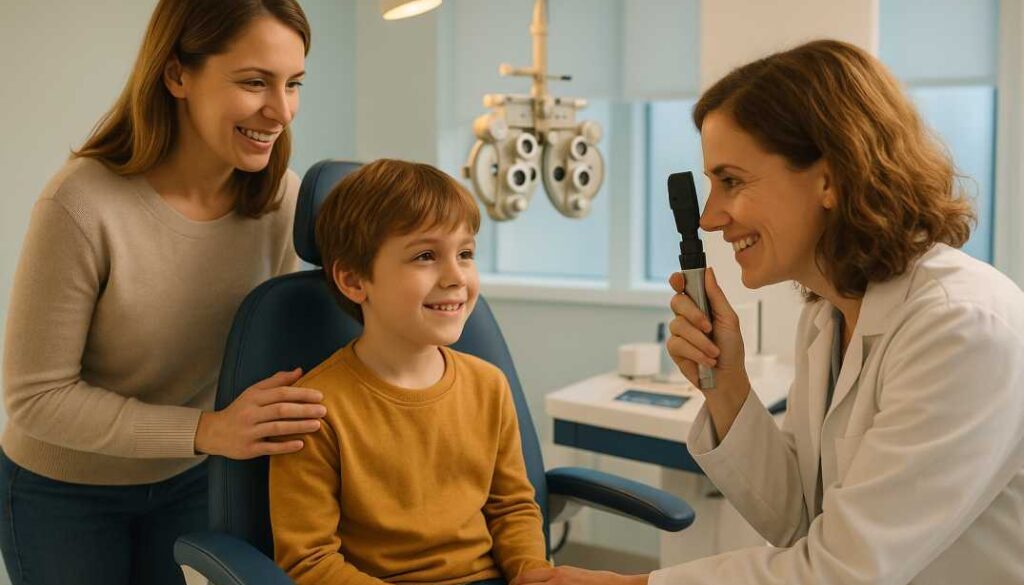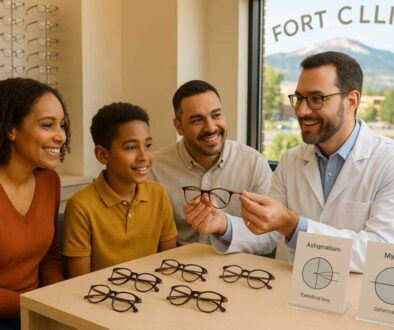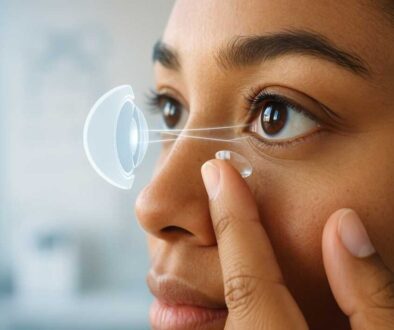Myopia in Children: Prevention & Treatment Guide
TL;DR: Myopia in children has reached epidemic proportions, affecting over one-third of children globally and projected to impact 740 million children by 2050. Early detection, outdoor activities, proper screen time management, and evidence-based treatments like low-dose atropine and specialty contact lenses can significantly slow progression and protect your child’s long-term eye health.
Understanding the Myopia Epidemic in Children
Myopia in children has emerged as one of the most pressing public health challenges of our time. Recent comprehensive research reveals that childhood myopia now affects approximately 35.8% of children worldwide, representing a dramatic increase from 24.3% just three decades ago. This alarming trend has led health experts to classify childhood myopia as a global epidemic that demands immediate attention from parents, healthcare providers, and policymakers alike.
At Poudre Valley Eyecare, we’ve witnessed this concerning trend firsthand during our 25+ years serving Fort Collins families. What was once considered a simple vision correction issue has evolved into a complex health concern that requires proactive management and family education.
Schedule Your Child’s Comprehensive Eye Exam Today
Don’t wait for symptoms to appear. Early detection is key to preventing myopia progression. Contact Poudre Valley Eyecare to schedule your child’s thorough eye examination with our experienced pediatric eye care specialists.
What Exactly Is Myopia in Children?
Myopia, commonly known as nearsightedness, occurs when the eye grows too long from front to back, causing light to focus in front of the retina instead of directly on it. In children, this condition typically develops between the ages of 5 and 14 and continues progressing until early adulthood.
Think of the eye like a camera that’s gradually becoming out of focus for distant objects. Children with myopia can see clearly up close—reading books or looking at phones—but distant objects like classroom whiteboards, street signs, or playing fields appear blurry.
Key characteristics of childhood myopia include:
- Difficulty seeing distant objects clearly
- Squinting to improve distance vision
- Eye strain and headaches
- Sitting closer to screens or holding books very close
- Complaints of blurry vision during sports or outdoor activities
The Alarming Statistics: How Common Is Myopia in Children?
The latest global research paints a sobering picture of childhood myopia prevalence:
Current Global Impact (2023-2024 Data)
- 35.8% of children worldwide now have myopia (most recent data)
- Tripled rates since 1990, with particularly notable increases post-COVID-19
- 740 million children projected to be affected by 2050 (39.8% global prevalence)
- Girls are affected more than boys (33.6% vs 30.5%)
- Adolescents show the highest rates at 47% prevalence
Regional Variations
The epidemic isn’t evenly distributed globally:
Highest Risk Regions:
- East Asia: 35.2% average prevalence
- Japan leads with 86% of children affected
- South Korea follows at 73.9%
- Singapore and Taiwan show 80-90% rates in teenagers
United States Trends:
- 36.1% of children ages 5-17 have myopia (2022 census-based estimates)
- Prevalence varies significantly: 41% in urban areas vs. 15.7% in rural areas
- Rates have increased substantially since the 1970s (from 25% to over 40% in adults)
Developing vs. Developed Countries:
- Developing nations: 31.9% prevalence
- Developed countries: 23.8% prevalence
- Urban areas show significantly higher rates than rural locations
Why Is Myopia in Children Increasing So Dramatically?
The rapid increase in myopia in children over just three decades clearly indicates that environmental factors are the primary drivers, as genetic changes cannot occur this quickly in populations.
Primary Contributing Factors
1. Reduced Outdoor Time Research consistently shows that children spending less than 90 minutes daily outdoors face significantly higher myopia risk. Natural sunlight exposure helps regulate eye growth by releasing dopamine in the retina, which slows axial elongation.
2. Increased Near Work and Screen Time
- Children now spend 2-4 hours daily on digital devices
- Close reading distances (less than 20cm) increase the risk
- Continuous near work for over 45 minutes without breaks
- Earlier formal education starting as young as 2-3 years old in some regions
3. Urban Lifestyle Changes
- More indoor activities and structured learning
- Reduced physical outdoor play
- Increased academic pressure and homework loads
- Limited exposure to natural lighting environments
4. COVID-19 Pandemic Impact The pandemic accelerated myopia development through:
- Extended remote learning periods
- Increased screen time for education and entertainment
- Reduced outdoor recreational activities
- Limited access to regular eye care services
Understanding the Serious Health Risks
Many parents mistakenly view myopia as simply needing glasses—a minor inconvenience easily corrected. However, myopia in children represents a progressive eye disease that poses significant long-term health risks.
Immediate Impact on Children
- Academic performance: Difficulty seeing classroom materials clearly
- Sports and activities: Reduced performance in distance-vision activities
- Social development: Potential reluctance to participate in group activities
- Quality of life: Dependence on corrective lenses and potential self-esteem issues
Long-Term Health Consequences
The earlier myopia develops and the more it progresses, the higher the risk of serious eye diseases in adulthood:
High Myopia Complications (myopia greater than -6.00 diopters):
- Retinal detachment: 10x higher risk than normal vision
- Myopic macular degeneration: Leading cause of blindness in developed countries
- Glaucoma: 2x increased risk
- Cataracts: Earlier development and more severe progression
The Power of Early Intervention: Reducing final myopia by just 1.00 diopter can:
- Decrease myopic macular degeneration risk by 40%
- Reduce open-angle glaucoma risk by 20%
- Lower the risk of visual impairment by 20%
Evidence-Based Treatment Options for Myopia in Children
The good news is that we now have proven treatments that can significantly slow myopia progression in children. Understanding myopia in children and implementing the right treatment approach is key to preventing long-term complications.
1. Low-Dose Atropine Eye Drops
How it works: Atropine drops relax the focusing mechanism and may influence scleral growth, slowing eye elongation.
Effectiveness:
- 0.01% concentration: 30-40% reduction in progression with minimal side effects
- 0.05% concentration: 50-67% reduction in progression; ranked as the most beneficial concentration
- Safe for children as young as 4 years old with proper monitoring
Considerations:
- Minimal side effects (slight pupil dilation, light sensitivity)
- Requires consistent daily application
- Regular monitoring by eye care professionals
- Off-label use requires informed consent
2. Specialty Contact Lenses
Orthokeratology (Ortho-K):
- Overnight contact lenses that reshape the cornea
- Approximately 50% reduction in myopia progression
- Provides clear daytime vision without glasses
- Best for children 8+ years who can handle lens care
MiSight Daily Disposable Lenses:
- FDA-approved for slowing myopia progression
- Dual-focus design with treatment and correction zones
- Suitable for children 8-12 years at treatment initiation
- 59% reduction in myopia progression shown in clinical trials
Multifocal Soft Contact Lenses:
- Center-distance designs showing 25-50% efficacy
- Daily disposable options are available
- Good option for children who are comfortable with contact lens wear
3. Specialty Eyeglass Lenses
Peripheral Defocus Lenses:
- DIMS (Defocus Incorporated Multiple Segments) technology
- HAL (Highly Aspherical Lenslets) designs
- 30-60% reduction in progression rates
- Normal appearance and easy adaptation for children
Progressive Addition Lenses:
- Most effective for children with near esophoria
- Limited effectiveness in the general population
- May be combined with other treatments
4. Combination Therapies
Recent research shows combining treatments may provide enhanced benefits:
- Atropine + Orthokeratology: Potentially greater progression control
- Atropine + Peripheral Defocus Lenses: Addressing multiple pathways
- Light Therapy + Traditional Treatments: Emerging research area
Lifestyle Modifications That Make a Difference
While medical treatments are crucial, lifestyle changes form the foundation of myopia prevention and control.
Outdoor Time Recommendations
- Minimum 90 minutes daily of outdoor activity
- Natural sunlight exposure is key, not just being outside
- Any outdoor activity counts: walking, playground time, sports
- Sun protection is important, but doesn’t negate benefits
- Family outdoor time encourages consistent habits
Healthy Screen Time Habits
The 20-20-20 Rule: Every 20 minutes, look at something 20 feet away for 20 seconds.
Additional Guidelines:
- Limit recreational screen time to 1-2 hours daily
- Maintain proper viewing distance (arm’s length for tablets/phones)
- Ensure good lighting when using screens
- Take regular breaks from near work
- Avoid screens 1 hour before bedtime
Creating a Myopia-Friendly Environment
- Optimize lighting: Use task lighting for reading and homework
- Encourage varied activities: Balance near work with distance activities
- Promote good posture: Proper seating and reading positions
- Regular eye breaks: Build breaks into homework and study time
When to Seek Professional Help
Early detection is crucial for effective myopia management. Parents should schedule comprehensive eye exams if they notice:
Warning Signs in Children
- Squinting to see distant objects
- Sitting very close to the TV or holding books close to the face
- Complaints of headaches or eye strain
- Difficulty seeing the board at school
- Rubbing eyes frequently
- Avoiding distance activities or sports
Recommended Eye Exam Schedule
- First comprehensive exam: By age 1 (or earlier if concerns)
- Preschool years: Ages 3-5 annually
- School age: Every 1-2 years or as recommended
- Higher risk children: More frequent monitoring
Risk factors requiring closer monitoring:
- Family history of myopia (especially high myopia)
- Early myopia onset (before age 8)
- Rapid progression (>0.50D per year)
- Limited outdoor time and high near-work demands
The Role of Genetics vs. Environment
Understanding the interplay between genetic predisposition and environmental factors helps families make informed decisions about prevention and treatment.
Genetic Risk Factors
- One myopic parent: 3x increased risk
- Two myopic parents: 6x increased risk
- High myopic parents: Higher progression rates in children
- Myopic siblings: Additional risk factor regardless of parental myopia
- Age-normal hyperopia: Children with less than +0.75D at age 6-7 face a 50% myopia risk
Environmental Modification
Even with genetic predisposition, environmental changes can significantly impact outcomes:
- Children with myopic parents can delay the onset through increased outdoor time
- Environmental interventions may reduce final myopia severity
- Early intervention is more effective than waiting for progression
Breaking Common Myths About Myopia in Children
Myth 1: “Myopia Can Be Cured”
Reality: Myopia in children cannot be cured or reversed, but progression can be significantly slowed with proper treatment and lifestyle modifications.
Myth 2: “It’s Just Genetics, Nothing Can Be Done”
Reality: While genetics play a role, environmental factors are the primary driver of the current epidemic. Lifestyle changes and treatments make a substantial difference.
Myth 3: “Screen Time Directly Causes Myopia”
Reality: The relationship is complex. It’s more about the balance between near work and outdoor time rather than screens alone causing myopia.
Myth 4: “Eye Exercises Can Prevent Myopia”
Reality: There’s no scientific evidence supporting eye exercises for myopia prevention. Proven interventions focus on outdoor time and myopia control treatments.
Myth 5: “Children Will Outgrow Myopia”
Reality: Myopia typically progresses throughout childhood and stabilizes in early adulthood. Without intervention, it often worsens over time.
Latest Research and Future Directions
The field of myopia research continues to evolve rapidly, with exciting developments on the horizon:
Emerging Treatments
- Red light therapy: Showing promise in Asian studies, pending broader research
- Scleral cross-linking: Experimental biomechanical approach for high myopia
- MyopiaX digital device: Targeting dopamine pathways through light therapy
- Bright light therapy (BLT): Home-based devices mimicking outdoor light exposure
Technology Advances
- AI-powered diagnostic tools: Earlier detection and progression prediction
- Wearable devices: Monitoring light exposure and near work patterns
- Telemedicine: Improved access to specialist care
- Personalized treatment plans: Based on individual risk factors and progression patterns
Public Health Initiatives
- School-based programs: Increased outdoor time and myopia screening
- Government policies: Reduced homework loads and mandatory outdoor time
- Community education: Raising awareness among parents and teachers
- Healthcare integration: Better coordination between pediatricians and eye care providers
Economic Impact and Healthcare Planning
The myopia epidemic carries significant economic implications:
Direct Costs
- Myopia correction costs: $328 billion annually for Asian adults (extrapolated regional data)
- High myopia complications: $200-250 billion annually in global healthcare costs
- Childhood treatments: Growing market with devices projected to reach $38.5 billion by 2034
Indirect Costs
- Educational impact: Reduced academic performance without proper correction
- Global productivity losses: Over $200 billion annually in lost productivity
- Quality of life: Long-term impacts on career and lifestyle choices
Practical Action Plan for Parents
Immediate Steps (This Week)
- Schedule a comprehensive eye exam for your child
- Assess current outdoor time and screen time habits
- Implement the 20-20-20 rule for screen use
- Improve lighting in study and play areas
Short-Term Goals (Next Month)
- Establish a consistent outdoor time routine (90+ minutes daily)
- Create screen time boundaries and enforce breaks
- Consult with an eye care professional about myopia risk factors
- Educate family members about myopia prevention
Long-Term Planning (Next 6 Months)
- If myopia is detected, explore appropriate treatment options
- Regular monitoring appointments with an eye care provider
- Adjust lifestyle habits based on professional recommendations
- Consider myopia management treatments if progression occurs
Questions to Ask Your Eye Care Provider
During your child’s eye examination, consider asking:
-
Risk Assessment: “What is my child’s risk for developing myopia based on family history and current refraction?”
-
Progression Monitoring: “How often should my child have eye exams, and what signs of progression should I watch for?”
-
Treatment Options: “If my child develops myopia, what treatment options are available and appropriate for their age and lifestyle?”
-
Lifestyle Modifications: “What specific lifestyle changes would you recommend for my child to reduce myopia risk or slow progression?”
-
Long-term Planning: “What can we expect for my child’s vision over the next few years, and how can we prepare?”
The Importance of Early Action
The evidence is clear: early intervention in childhood myopia provides the greatest opportunity to preserve long-term eye health. Every month of delay in treatment can result in additional progression that cannot be reversed.
Key takeaways for parents:
- Myopia in children is not “just needing glasses”—it’s a progressive eye disease with serious long-term consequences
- Current treatments can slow progression by 30-60%, significantly reducing lifetime myopia
- Environmental modifications (outdoor time, screen habits) are safe and effective for all children
- Early detection through regular eye exams is crucial for optimal outcomes
- The combination of professional treatment and lifestyle modifications provides the best results for managing myopia in children.
Supporting Your Child Through Myopia Management
Managing childhood myopia requires a team approach involving parents, children, and eye care professionals. At Poudre Valley Eyecare, we understand that this journey can feel overwhelming for families. Here are strategies to support your child:
Building Confidence
- Emphasize that myopia is common and treatable
- Focus on the positive aspects of treatment (better vision, healthier eyes)
- Involve children in age-appropriate decision-making about their care
- Connect with other families managing childhood myopia
Treatment Compliance
- Establish routines that make treatments part of daily life
- Use positive reinforcement for consistent treatment use
- Address any concerns or side effects promptly with your eye care provider
- Celebrate milestones and successful progression control
Additional Resources and Expert Citations
For parents seeking more detailed information about myopia in children, these authoritative resources provide comprehensive guidance from leading eye care organizations and research institutions:
Key Research and Clinical Resources
-
International Myopia Institute – Clinical Management Guidelines
- Comprehensive evidence-based guidelines for myopia management in children
- Detailed treatment protocols and monitoring recommendations
- Updated clinical best practices from global myopia experts
-
My Kids Vision – Parent Education Platform
- Free online resource developed by eye care professionals specifically for parents
- Interactive tools for assessing myopia risk factors in children
- Practical guidance on lifestyle modifications and treatment options
-
National Eye Institute – Myopia Research Updates
- Latest scientific findings from the National Eye Institute
- Updates on global myopia prevalence and prevention strategies
- Information about ongoing clinical trials and breakthrough treatments
These resources complement the information in this guide and provide additional depth for parents wanting to learn more about protecting their child’s vision health.
Conclusion: Protecting Your Child’s Vision Future
Myopia in children represents one of the most significant eye health challenges of our generation, but it’s a challenge we’re well-equipped to address. With a comprehensive understanding of myopia in children, early intervention, and consistent management, we can significantly slow progression and protect children’s long-term eye health.
The key is action—not waiting to see what happens, but taking proactive steps to assess risk, modify lifestyle factors, and implement appropriate treatments when needed. Every child deserves the opportunity for healthy vision throughout their lifetime.
At Poudre Valley Eyecare, we’re committed to partnering with Fort Collins families in this important journey. Our 25+ years of experience, combined with the latest evidence-based treatments and technology, provide the comprehensive care your child needs for optimal eye health.
Remember: The earlier we intervene, the better the outcomes. Don’t wait for myopia to progress—schedule a comprehensive eye exam today and take the first step toward protecting your child’s vision future.
Take Action Now – Protect Your Child’s Vision
Contact Poudre Valley Eyecare to:
- Schedule a comprehensive pediatric eye examination
- Discuss myopia risk factors specific to your family
- Explore evidence-based treatment options if needed
- Create a personalized vision protection plan for your child
Conveniently located in Fort Collins | Accepting new patients | Most insurance plans accepted
FAQs
-
-
Myopia in children means they can see nearby objects clearly but struggle to see things far away. It often needs glasses for correction.
-
Please note: None of the above should be considered medical advice. If you’re having any concerns about your vision, please reach out to us immediately or see your primary care provider.





